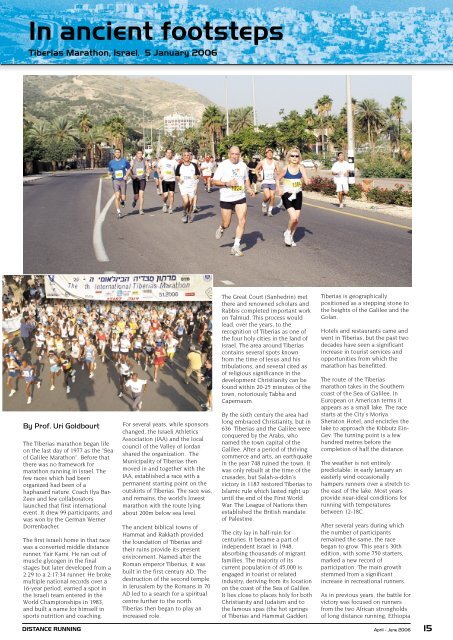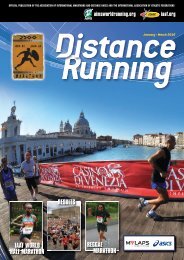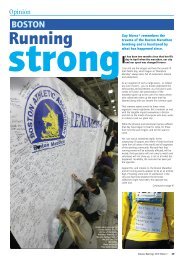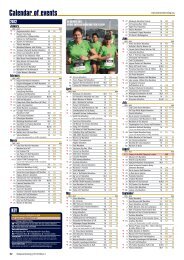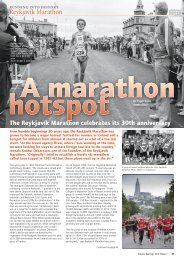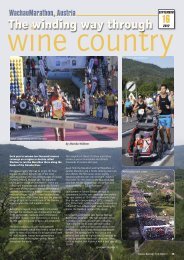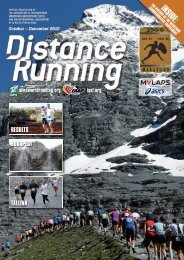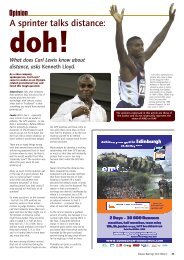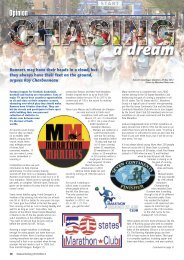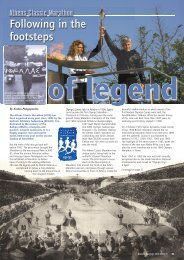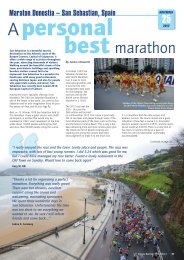Download pdf - Distance Running magazine
Download pdf - Distance Running magazine
Download pdf - Distance Running magazine
- No tags were found...
You also want an ePaper? Increase the reach of your titles
YUMPU automatically turns print PDFs into web optimized ePapers that Google loves.
In ancient footstepsTiberias Marathon, Israel. 5 January 2006By Prof. Uri GoldbourtThe Tiberias marathon began lifeon the last day of 1977 as the "Seaof Galilee Marathon". Before thatthere was no framework formarathon running in Israel. Thefew races which had beenorganized had been of ahaphazard nature. Coach Ilya Bar-Zeev and few collaboratorslaunched that first internationalevent. It drew 99 participants, andwas won by the German WernerDorrenbacher.The first Israeli home in that racewas a converted middle distancerunner, Yair Karni. He ran out ofmuscle glycogen in the finalstages but later developed from a2:29 to a 2:17:34 runner. He brokemultiple national records over a16-year period, earned a spot inthe Israeli team entered in theWorld Championships in 1983,and built a name for himself insports nutrition and coaching.For several years, while sponsorschanged, the Israeli AthleticsAssociation (IAA) and the localcouncil of the Valley of Jordanshared the organization. TheMunicipality of Tiberias thenmoved in and together with theIAA, established a race with apermanent starting point on theoutskirts of Tiberias. The race was,and remains, the world’s lowestmarathon with the route lyingabout 200m below sea level.The ancient biblical towns ofHammat and Rakkath providedthe foundation of Tiberias andtheir ruins provide its presentenvironment. Named after theRoman emperor Tiberius, it wasbuilt in the first century AD. Thedestruction of the second templein Jerusalem by the Romans in 70AD led to a search for a spiritualcentre further to the north.Tiberias then began to play anincreased role.The Great Court (Sanhedrin) metthere and renowned scholars andRabbis completed important workon Talmud. This process wouldlead, over the years, to therecognition of Tiberias as one ofthe four holy cities in the land ofIsrael. The area around Tiberiascontains several spots knownfrom the time of Jesus and histribulations, and several cited asof religious significance in thedevelopment Christianity can befound within 20-25 minutes of thetown, notoriously Tabha andCapernaum.By the sixth century the area hadlong embraced Christianity, but in636 Tiberias and the Galilee wereconquered by the Arabs, whonamed the town capital of theGalilee. After a period of thrivingcommerce and arts, an earthquakein the year 748 ruined the town. Itwas only rebuilt at the time of thecrusades, but Salah-a-ddin'svictory in 1187 restored Tiberias toIslamic rule which lasted right upuntil the end of the First WorldWar. The League of Nations thenestablished the British mandateof Palestine.The city lay in half-ruin forcenturies. It became a part ofindependent Israel in 1948,absorbing thousands of migrantfamilies. The majority of itscurrent population of 45,000 isengaged in tourist or relatedindustry, deriving from its locationon the coast of the Sea of Galilee.It lies close to places holy for bothChristianity and Judaism and tothe famous spas (the hot springsof Tiberias and Hammat Gadder).Tiberias is geographicallypositioned as a stepping stone tothe heights of the Galilee and theGolan.Hotels and restaurants came andwent in Tiberias, but the past twodecades have seen a significantincrease in tourist services andopportunities from which themarathon has benefitted.The route of the Tiberiasmarathon takes in the Southerncoast of the Sea of Galilee. InEuropean or American terms itappears as a small lake. The racestarts at the City's MoriyaSheraton Hotel, and encircles thelake to approach the Kibbutz Ein-Gev. The turning point is a fewhundred metres before thecompletion of half the distance.The weather is not entirelypredictable: in early January aneasterly wind occasionallyhampers runners over a stretch tothe east of the lake. Most yearsprovide near-ideal conditions forrunning with temperaturesbetween 12-18C.After several years during whichthe number of participantsremained the same, the racebegan to grow. This year's 30thedition, with some 750 starters,marked a new record ofparticipation. The main growthstemmed from a significantincrease in recreational runners.As in previous years, the battle forvictory was focused on runnersfrom the two African strongholdsof long distance running, EthiopiaDISTANCE RUNNING April - June 200615


